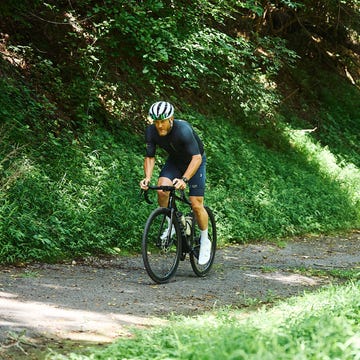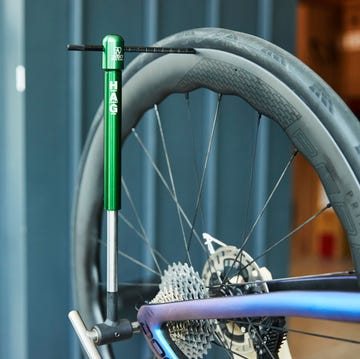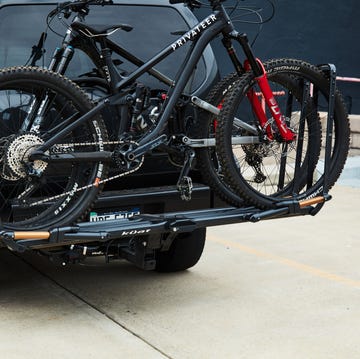Bike pumps are the unsung heroes of cycling. You wouldn’t get very far without one, whether it’s a mini pump that goes along for the ride or a hard-working floor pump in the garage. Either way, both serve the same purpose: to inflate your tires. A floor pump typically does its job faster and with better accuracy, while a mini pump can get you out of a jam and back in action until you’re home again, where you can top off your tire pressure with a floor pump. Ideally, you should have one of each and be comfortable using both.
The Best Bike Pumps
- Best Overall Floor Pump: Silca Terra
- Best Cheap Pump: Vibrelli Bike Floor Pump
- Best Value Floor Pump: Specialized Air Tool Comp
- Best Floor Pump for Off-Road Tires: Specialized Air Tool MTB
- Best Mini Pump: Topeak Mountain DA Mini
How We Selected These Pumps
We tested more than 30 pumps—floor and mini—across all types of tires, from skinny road to fat mountain and gravel. All of the pumps were evaluated on performance, price, durability, ease of use, and gauge readability (when applicable). For floor pumps, we also evaluate stability and how long it takes to inflate a tire. High volume pumps were evaluated using a 29-inch mountain bike tire and high pressure pumps were tested on 30mm road tires. For mini pumps, we measured pressure after 200 strokes—the upper limit of our collective forearm strength.
Gauge accuracy is one of the most common questions we get. To answer it, we built a custom device to compare each pump’s readout (up to 100 psi) with a reference standard.
Bicycling has been testing bikes and gear for over 50 years. Our recommendations are backed by a team with more than 60 years of combined experience, including Deputy Editor Tara Seplavy, Senior Test Editor Matt Phillips, Test Editor Dan Chabonov, and Senior Reviews Editor Bobby Lea.
These 10 pumps stood out for their accuracy, durability, and overall value—and they’ve earned permanent spots in our garages and workshops.
Our Full Pump Reviews
At 2 feet tall, the Vibrelli is a few inches shorter than the average floor pump, making it a more convenient travel companion. We found it easy to jigsaw into a trunk already overcrowded with bikes and gear. And since it’s so light (2.75 pounds), it won’t push your checked baggage over the airline’s weight limit. Our testing found that the gauge was accurate up to 100 psi (the max pressure our testing device will measure), although the graduations on the dial go all the way up to 160 psi. This pump is best for road and thin gravel tires. Although you can fill fat tires with the Vibrelli, it’s not a high-volume pump, so you’ll get a tricep workout filling mountain bike tires. Although the shaft is steel, the base and handle are plastic. That’s not a deal breaker, but it means the pump isn’t as robust as the more expensive ones on this list. But at this price, it’s a great value.
This pump won our mini-pump testing. It’s noticeably larger than the rest of the minis we've tested, but it really works. Despite being best suited for high-volume tires, it also does a solid job getting road tires back to serviceable riding pressure. And since it’s a dual-stroke type, it inflates tires extremely fast. Also, it has a built-in gauge, so we were never left wondering just how much (or how little) air we had managed to cram back into our tires. For both flat repair and “Oh damn, I left my floor pump at home” moments, the Mountain DA is a lifesaver.
Silca has made many good pumps over the years. Some of these have been extremely expensive, and while the Terra's $140 price point is not cheap, it is the most affordable floor pump in Silca’s lineup. But much more importantly, I would argue that it is the best floor pump Silca has made.
The dual-stage gauge is excellent at providing precise inflation below 30 psi for gravel and mountain bike tires. But with an overall capacity of 120 psi, the Terra also works great for road tires. The build quality is excellent, with a beautiful wood handle and subdued earth tone color scheme. The pump feels solid but is light enough to be easy to travel with.
The pump head feels extremely solid, with all-metal construction and a firm locking lever. It can easily convert between Presta and Schrader valves and it also has a very precise bleed valve. In our testing, we could consistently bleed off half of a PSI when inflating off-road tires below 30 psi.
The Terra was an easy consensus choice for our best overall pump. It was consistently the pump everyone reached for; its gauge is accurate (and easy to read), plus it has a noticeably smoother pump action compared to all the pumps we tested. While it's not a cheap pump, its price reflects its quality.
If you like to obsess over minute pressure differences under 35 psi, this is your pump. The gauge on the left measures up to 35 psi, and the markings are in large, one-pound increments that make it very easy to see and manage fine tweaks in your tire pressure. Once you pass 35 psi, the gauge on the right kicks in and reads up to 75 psi. The high-volume stroke fills fat tires quickly, and the metal gauge, wide stance, and comfortable grip make the Dualie a pleasure to use. It's one of the more expensive high volume floor pumps on this list, but year after year this pump has proven its value. Our pump has held up to over 6 years of abuse doled out by Senior Reviews Editor Bobby Lea and is showing no signs of slowing down.
Specialized's Air Tool Comp has a dual-range pressure gauge (similar to the pricier Silca Terra). Half of the gauge is for low pressures and runs from zero to 30 psi in one-psi gradients, while the other half is for high-pressure tires and runs from 30 to 120 psi in two-psi gradients. However, unlike the Silca Terra, the gauge leaves something to be desired when it comes to accuracy. Our testing found that it reads two psi low for pressures up to 30 psi, then reads between four and five psi low from 35 up to 100. However, the variations are consistent and repeatable, meaning the Air Tool Comp will inflate your tire the same way every time. Although we also wish the pump head had a bleed valve, we still use it regularly and appreciate its versatility across a wide range of tire sizes and widths.
This high-volume pump is, as the name suggests, made specifically for filling mountain bike tires. The three-inch gauge goes up to only 40 psi, with big, easy-to-read markings in one-pound increments. Of all the pumps on this list, this one has the gauge that’s the easiest to use for setting a precise tire pressure. The stable metal base is the same as the Air Tool and Air Tool Comp V2. Like those pumps, the Air Tool MTB also has a metal barrel, although it’s much larger in diameter to move a higher volume of air with each stroke. And move a lot of air it does—it took us only 20 strokes to fill a 29 x 2.6-inch tire to 20 psi. The plastic handle and loose-fitting plunger give the feel of a discount product. However, testing confirmed that this pump’s gauge is accurate at all points, and we consistently reach for the Air Tool when filling mountain bike tires. We wished for only one thing: a release valve to let out the pressure. Though it may seem minor, it’s incredibly useful when you’re trying to hit 17 psi and you accidentally overfill.
From BikeTube, an online store specializing in (surprise!) bike tubes, comes the Air Handler Floor Pump. In keeping with the rest of the products the company offers, this is a high-value and high-performing floor pump. The steel base provides a very solid platform, and the aluminum barrel resists heat expansion while keeping overall weight low. We like how the wide handle with rubber grips feels in our hands, and the industrial-grade pressure gauge is rated to within 2 percent accuracy. This pump has been knocking around our office for years and it just won’t die. The gauge isn’t perfectly accurate, but it’s consistent. It’s most off the mark at the low end of the gauge; at 45psi the pump was registering only 40psi. But it gave more accurate readings at higher pressures. What the dial claims was 80psi we confirmed was actually 83psi, but at 100psi the pump read only one psi low. This isn't the best option if you need to dial in precise pressure (+/- 1 psi) to high volume tires, but it's a great jack of all trades pump.
If you’ve got the floor pump department covered but are in need of a mini pump, the Air Handler Mini is a great option. It’s compact (only 6.3 inches long), light, and can crank out a lot of air in a relatively short amount of time thanks to its two-stage pumping design and internal piston that pumps air in both directions. For filling fat tires and starting off a road tire, flip a level to HV (high volume). Once the going gets a little tougher, flip the switch the other way for high pressure (HP), and you can crank your road tires up to 120 psi. Like the floor-pump version, the mini also has what BikeTube calls Auto Head, which accepts both Schrader and Presta valves.
There are many different CO2 inflators out there. Most will empty a CO2 cartridge into your tire just fine, but Lezyne Control Drive CO2 does that job just a bit better. The dial used to open and close the valve feels precise and robust, so if you use larger-size CO2 cartridges, you can dispense just the right amount of air without wasting the rest. Its CNC construction feels durable, plus it's compatible with both Presta and Schrader valves.
The TLR Flash Charger is a good alternative to an air compressor when it comes to installing tubeless tires. The large vertical tank can be pressurized to 160 psi, the maximum pressure read by the digital gauge. To install tubeless tires, place the nozzle on the valve, and when the tank is pressurized, flip the release lever from Charge to Inflate. Opening and closing that lever isn’t a binary choice—you can modulate the pressure as it’s released.
When installing a mountain bike tire, we were nervous about blasting in 160 pounds at one shot but found it very handy to let air in small bursts, giving the tire time to settle. The TLR Flash Charger also works well as a traditional high-pressure pump. The digital gauge is, according to our testing, accurate up to 100 psi, which is the maximum pressure our testing device measures, and that gauge measures pressure in one-tenth increments. The pump is a little big and unwieldy to throw into the back of a car, but it’s a great tool for the home workshop and a must-have for home mechanics who regularly install tubeless tires (and don't want to spend the money for an air compressor). We know the price is steep, but this pump has proven its durability for us several times over.
We tested several alternatives to the TLR Flash Charger, such as the Topeak JoeBlow Booster and the Lezyne Pressure Over Drive. Functionally both were fine, but they weren't quite as polished as the Bontrager pump, and neither was significantly cheaper. Lezyne's offering has a very sturdy but extremely annoying to use pump head. The threaded chuck simply takes too long to attach to the valve, which lead us to consistently avoid using it outside of testing. The JoeBlow version was completely adequate, but it's five dollars more than our pick and doesn't have a digital gauge.
If you want to ride with a frame pump, there is really only one option. Silca's Impero Ultimate is sturdy, reliable, rebuildable, powerful, and beautiful. It comes in multiple sizes, so you'll need to measure your frame and select the size that fits. I've owned one of these pumps for eight years; it still functions as well as the day I got it. There's simply no reason to buy a different frame pump.
Test Editor Dan Chabanov got his start in cycling as a New York City bike messenger but quickly found his way into road and cyclocross racing, competing in professional cyclocross races from 2009 to 2019 and winning a Master’s National Championship title in 2018. Prior to joining Bicycling in 2021, Dan worked as part of the race organization for the Red Hook Crit, as a coach with EnduranceWERX, as well as a freelance writer and photographer.
As Deputy Editor, Tara Seplavy leads Bicycling’s product test team; after having previously led product development and sourcing for multiple bike brands, run World Championship winning mountain bike teams, wrenched at renowned bicycle shops in Brooklyn, raced everything from criteriums to downhill, and ridden bikes on six different continents (landing herself in hospital emergency rooms in four countries and counting). Based in Easton, Pennsylvania, Tara spends tons of time on the road and trail testing products. A familiar face at cyclocross races, crits, and bike parks in the Mid Atlantic and New England, on weekends she can often be found racing for the New York City-based CRCA/KruisCX team. When not riding a bike, or talking about them, Tara listens to a lot of ska, punk, and emo music, and consumes too much social media.

























